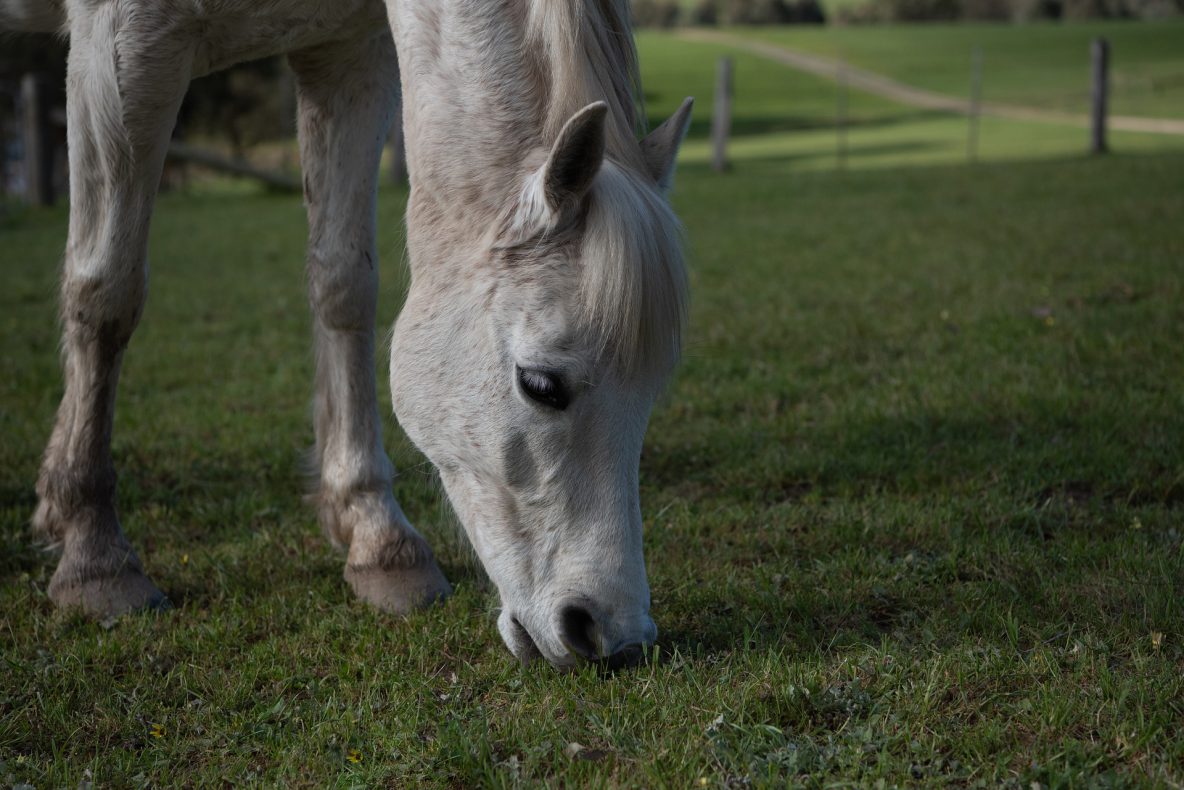EQUINE GRASS SICKNESS
Equine grass sickness (EGS) is a disease of the nerves that coordinate intestinal movement, which causes the digestive system to stop functioning properly. It is a recognized condition of grazing horses which is often fatal. Recognized the first time in Scotland more than 100 years ago, has now been reported in other part of England, Europe, South America and Australia. The condition is not common on our practice area but occasionally does occur especially in upland areas such as the Quantocks and the Blackdown hills.
Although EGS has been studied extensively, the cause of the disease remains unclear. It is now believed that it may be caused by the toxins produced by an environmental bacterium (Clostridium botulinum). Under certain environmental conditions the bacteria produce a toxin in the horse’s intestine that results in paralysis of the intestines.
Horses with EGS are generally between 2 and 12 years old with a higher risk for those younger than 7 and recently introduced to an area.
Grass sickness occurs in several different forms, ranging from acute to chronic. Most horse are depressed and dysphagic due to an impair function of the cranial nerve. Horse are seen drooling saliva, have feed material in the nares, impacted feed material in the buccal pouches, and difficulty drinking.
- The acute form is the most serious and the course of the disease is often less than 48 hours. It is of rapid onset, the horse is severely distressed, has an elevated heart rate, patchy sweating, muscle fasciculations, and may be dull and depressed. Moderate quantities of green fluid may be produced from the nostrils. Horses with acute grass sickness are often confused with colic, but rarely roll or go down. The abdominal pain is caused by the stasis of gut movements, distended stomach and small intestine, and usually no faeces will be produced. Choke is another disease that is not infrequently confused with grass sickness. Veterinary attention is required urgently. Often when a stomach tube is passed a vast quantity of grass fluid will flow back. If your vet is sure the horse has acute grass sickness then destruction on humane grounds may be only option, and the horse should not be allowed to continue to suffer.
- Signs of sub-acute ECS are similar but less severe. Affected animals rarely have gastric or small intestinal distention, but develop large colon impactions. The heart rate is elevated, the horse will show patchy, muscle tremor, and an inability to swallow (dysphagia). The course of the disease is 2 – 7 days. The mortality rate is nearly 100%.
- In the chronic form , horses show little or no pain but have reduced amount of droppings. It accounts for around a third of EGS cases, has more of a gradual onset of clinical signs. Most notable is rapid weight loss, while a ‘tucked up’ abdominal appearance and abnormal stance may develop. Horses affected by this slower onset (chronic) form of the disease become very depressed and have difficulty eating food. Some cases survive after long periods of intensive care, but many never thrive and become more susceptible to choke and impaction colic.
Since the symptoms of grass sickness are non specific of the condition, and clinical manifestations of the disease are so varied in individual cases, the diagnosis can sometimes be very difficult to make.
In many cases with acute or low-grade persistent colic, a surgical exploration of the abdominal organs under general anaesthesia may be needed to rule out other intestinal conditions such as ‘twists’ and displacements bowel. A biopsy (collection of a tissue sample) of the small intestine’s wall for microscopic examination may be necessary.
A Definitive diagnosis is often made, in those cases that die or require euthanasia on humane grounds, on the basis of post mortem examination. Typical signs of nerve cell damage are found in specific nerve centres (sympathetic mesenteric ganglia).
Can grass sickness be treated?
Most cases of grass sickness are either fatal or require euthanasia on humane grounds. Horses with signs of acute and sub-acute grass sickness will not respond to treatment because their intestines are irreparably paralysed and they should be humanely destroyed as soon as the diagnosis can be reliably made.
Some horses with the chronic form of the disease have been successfully treated with long-term (weeks-months) supportive therapy which required the horse to be hospitalized. It is only suitable for those that have only slight and partial intestinal paralysis.
The survivor may return to work, but some display residual abnormalities such as mild dysphagia and sweating. They, also, seems to be more susceptible to choke and to colonic and rectal impactions thereafter and need careful dietary management for the rest of their lives.
Can grass sickness be prevented?
Although there is a seasonal (late spring and summer) increase in the number of cases diagnosed, animals can be affected at any time of the year (autumn seems to see an increased in cases).
Particularly exposed to the risk seems to be horses turned out to grazing after a period of stabling and those turned out recently onto new pasture. Grass sickness cases occasionally occur in groups of horses, meaning that more than one animal may be affected in a single paddock or in a particular area at about the same time. Cases often occur following the first good rainfall after a period of drought. Most however, are single isolated cases and some may be old horses that have lived on the same pasture for most of their lives.
Some advices particularly relevant to the owners of horses on ‘high risk’ premises (i.e. premises that have recently given rise to a case of EGS):
- Avoid grazing horses at risk age group (2 – 7 years) out onto pasture where there have been previous cases.
- Horses turned out to grazing after a period of stabling (i.e. racehorses who are resting or retiring, should not be just turned out on grass only, but should continue to receive some hay and concentrate feed), and those turned out recently onto new pasture appear to be particularly at risk. Therefore, avoid changes in management during the high-risk Spring period (April – June), as well as avoid changes in diet (this seems to be one of the biggest factors for EGS).
- Always feed some conserved forage (hay/haylage) even when horses are turned out 24 hours a day.
- Avoid any sort of digging up in the pastures of grazing horses. Mechanical removal of droppings is an increased risk factor.
- Avoid the intensive use of worming drugs in the months leading up to the high-risk spring period. Worm control is obviously important but the over-use of worming drugs may increase the risk of EGS. Talk to one of our vets about getting the balance right.
- Where a case has occurred, horses in-contact should be relocated to another paddock and should be brought into stables for a couple of hours each day to be fed hay and some concentrate food.
- When a horse on particular premises is diagnosed with the disease, there is an increased risk of other horses close-by also suffering from the disease for a period of approximately one month (clustering in time and space). The radius of increased risk is at least 10km; risk is highest on the affected premises and decreases with distance from those premises.
- If certain fields are “bad” for the disease, they can be grazed by other stock, especially in spring and summer.
- If a case occurs amongst a group of horses, it is probably best to move the others out of that field, provided this does not involve too much stress associated with transportation or mixing with strange horses. If horses cannot be moved from the pasture then supplementary feeding with hay, haylage or hard feed may reduce the amount of grass the horses eat. It has been suggested that feeding haylage to grazing horses may have a protective effect
Sadly, it is not possible to protect your horse 100% from grass sickness but the following advice may help.
Bright side is that research is continuing. Until a causative agent is confirmed, we would advice to follow the above preventive measures.
For further information and research :
https://www.moredun.org.uk/research/diseases/equine-grass-sickness

